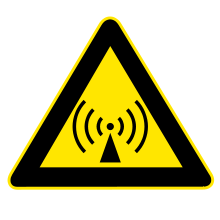- Non-ionizing radiation
-

Non-ionizing (or non-ionising) radiation refers to any type of electromagnetic radiation that does not carry enough energy per quantum to ionize atoms or molecules—that is, to completely remove an electron from an atom or molecule.[1] Instead of producing charged ions when passing through matter, the electromagnetic radiation has sufficient energy only for excitation, the movement of an electron to a higher energy state. Nevertheless, different biological effects are observed for different types of non-ionizing radiation.[2][3]
Near ultraviolet, visible light, infrared, microwave, radio waves, and low-frequency RF (longwave) are all examples of non-ionizing radiation. Visible and near ultraviolet may induce photochemical reactions, ionize some molecules or accelerate radical reactions, such as photochemical aging of varnishes[4] or the breakdown of flavoring compounds in beer to produce the "lightstruck flavor".[5] The light from the Sun that reaches the earth is largely composed of non-ionizing radiation, with the notable exception of some ultraviolet rays. However, most ionizing radiation is filtered out by the Earth's atmosphere. Static fields do not radiate.[3]
Health risks
Non-ionizing radiation can produce non-mutagenic[citation needed] effects such as inciting thermal energy in biological tissue that can lead to burns.
In terms of potential biological effects, the non-ionizing portion of the spectrum can be subdivided into:
- The optical radiation portion, where electron excitation can occur (visible light, infrared light)
- The portion where the wavelength is smaller than the body, and heating via induced currents can occur (MW and higher-frequency RF)
- The portion where the wavelength is much larger than the body, and heating via induced currents seldom occurs (lower-frequency RF, power frequencies, static fields).[3]
[2] Source Wavelength Frequency Biological effects UVA Black light, sunlight 318–400 nm 750–950 THz Eye – photochemical cataract; skin – erythema, inc. pigmentation Visible light Lasers, sunlight, fire, LEDs, light bulbs 400–780 nm 385–750 THz Skin photoaging; eye – photochemical & thermal retinal injury IR-A Lasers, remote controls 780 nm – 1.4 µm 215–385 THz Eye – thermal retinal injury, thermal cataract; skin burn IR-B Lasers 1.4–3 µm 100–215 THz Eye – corneal burn, cataract; skin burn IR-C Far-infrared laser 3 µm – 1 mm 300 GHz – 100 THz Eye – corneal burn, cataract; heating of body surface Microwave PCS phones, some mobile/cell phones, microwave ovens, cordless phones, motion detectors, long-distance telecommunications, radar, Wi-Fi 1 mm – 33 cm 1–300 GHz Heating of body tissue Radio-frequency radiation Mobile/cell phones, television, FM, AM, shortwave, CB, cordless phones 33 cm – 3 km 100 kHz – 1 GHz Heating of body tissue, raised body temperature Low-frequency RF Power lines >3 km <100 kHz Cumulation of charge on body surface; disturbance of nerve & muscle responses Static field[3] Strong magnets, MRI Infinite 0 Hz Magnetic – vertigo/nausea; electric – charge on body surface Ultraviolet radiation
Ultraviolet light can cause burns to skin[6] and cataracts to the eyes.[6] Ultraviolet is classified into near, medium and far UV according to energy, where near ultraviolet is non-ionizing. Ultraviolet light produces free radicals that induce cellular damage, which can be carcinogenic. Ultraviolet light also induces melanin production from melanocyte cells to cause sun tanning of skin. Vitamin D is produced on the skin by a radical reaction initiated by UV radiation.
Plastic (polycarbonate) sunglasses generally absorb UV radiation. UV overexposure to the eyes causes snow blindness, which is a risk particularly on the sea or when there is snow on the ground.
Visible and infrared, lasers
Visible light causes few effects to the human body. Bright visible light irritates the eyes. Visible-light lasers have much more powerful effects and may damage the eyes even at small powers. Very strong visible light is used for cauterizing hair follicles.
See also
- Ionizing radiation
- Electromagnetic hypersensitivity
- Mobile phone radiation and health
- Electromagnetic radiation and health
- Wireless electronic devices and health
- Electronic harassment
References
- ^ "Ionizing & Non-Ionizing Radiation". http://www.epa.gov/radiation/understand/ionize_nonionize.html.
- ^ a b Kwan-Hoong Ng (20 – 22 October 2003). "Non-Ionizing Radiations – Sources, Biological Effects, Emissions and Exposures" (PDF). Proceedings of the International Conference on Non-Ionizing Radiation at UNITEN ICNIR2003 Electromagnetic Fields and Our Health. http://www.who.int/peh-emf/meetings/archive/en/keynote3ng.pdf.
- ^ a b c d John E. Moulder. "Static Electric and Magnetic Fields and Human Health". http://www.mcw.edu/gcrc/cop/static-fields-cancer-FAQ/toc.html.
- ^ Helv. Chim. Acta vol. 83 (2000), pp. 1766
- ^ Photochemical & Photobiological Sciences, 2004, 3, 337-340, DOI: 10.1039/b316210a
- ^ a b "UW EH&S Hazards of Ultraviolet Light". http://www.ehs.washington.edu/rsononion/uvlight.shtm.
External links
Radiation (Physics & Health) Main articles Non-ionizing radiationElectromagnetic radiation
and healthRadiation therapy · Radiation poisoning · Radioactivity in the life sciences · List of civilian radiation accidents
Health physics · Laser safety · Lasers and aviation safety · Mobile phone radiation and health · Wireless electronic devices and healthRelated articles
Wikimedia Foundation. 2010.

